Message error - I can’t get the pictures to post.
Kitbashed prewar American Flyer
Something that is often forgotten by today’s toy train enthusiast is that there was a time when these toys were the focus of adults with an interest in building a model railroad empire. Many of these model railroaders were content with simply running tinplate toy trains in a prototypical manner, however, there were many others who chose to use an existing toy train as a starting point for constructing something which appeared more like the prototype. These modified, or kitbashed, toy trains ran the gamut from crude to extremely well fashioned and the efforts of these early model railroaders were featured in issues of Model Craftsman (later Railroad Model Craftsman) and Model Railroader.
For example, the June 1936 Model Railroader cover featured a layout with a number of modified toy trains.
As you can see from an up close detail the model railroader not only modified the toy trains but also mixed and matched manufacturers.
Steeple Cab - Uncataloged #7110
American Flyer is well known for putting together sets for special accounts. Perhaps some of the best documented “uncataloged” items were items produced for Montgomery Ward. While the items weren’t cataloged in the Flyer catalogs they obviously appeared in the Montgomery Ward catalog. (There is also an entry back a few pages on page 44 about the Nation Wide Lines equipment produced for J C Penney)
The #7110 Steeple Cab appeared in the 1929 and 1930 Ward’s Catalog.
I haven’t been able to find any copies of the catalogs for those years but this is how Schuweiler describes the set in the Greenberg Guide:
“Of the two uncataloged sets offered in the Fall and Winter 1929-1930 Ward catalogs, the first …features a steeple cab locomotive with four lithographed freight cars…”
I’d like to know what those four cars were so
Reference to 7011 here:
http://www.tcaetrain.org/articles/collecting/Nationwidelines/index.html

On Ebay
WallyWorld,
Thanks for the links to the Catalog on eBay and to the article on Nationwide Lines. Its amazing how much information that you can find on the internet with persistance and time.
Steeple Cab - Uncataloged # 7011
The #7011 was also produced for Montgomery Ward and appeared in the 1929-1930 Fall-Winter Catalog. It pulled a consist of Illini cars.
It is the same green color as the #7010. It has the typical steeple cab body but it has been mounted on a the longer #3115 type frame that has the cast sand barrels on each corner. It comes in several variations. (Wouldn’t you know Flyer couldn’t be satisfied with just one.) This version doesn’t quite match any of the three variations that Schuweiler documents in the Greenberg Guide, so perhaps there are at least 4 variations. It comes closest to version (A) but that version is not supposed to have journal boxes.
Like the 7010 it has identifying “Motor 7011” rubber stamped in four locations near the grills.
It’s interesting that the detail of upright sand domes on the extended end platforms on the Wards frame seem to copy an Illinois Terminal Class C electric. I always thought a Class C or B would have been a good tinplate prototype with those arched windows and turtle back roof. An unusual feature. I think some NYC electrics had this same feature of end sand domes…
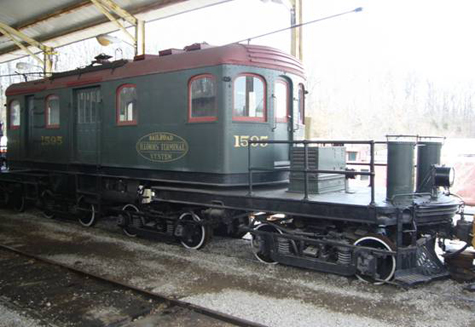
Wally World,
What a great prototype photo. Where is that engine located?
It may not be an exact replica, but Flyer’s 3020 does have two pony trucks with the distinctive sand domes.
Schuweiler says that it is an example of the New York Central T-Type locomotive.
Enjoying the World’s Greatest Hobby
Northwoods Flyer
Hi
It’s in Museum of Transportation in St Louis and the only example not scrapped. The B variation only had two trucks ( which the C was reconfigured from the B’s) There was a later D model whose appearance is bizarre, the body was unchanged ( arch windows, turtle back roof) but had a streamlined cover over the platform. Now I have to find a 3020. The variety of AF electrics is a revelation to me. The IT ran interurban passenger service, electric, steam and and diesel freights. Even a railbus to a streamliner. Ran from St Louis to Danville Ill one of the longer interurban routes, crossed the center width of Illinois east to west. Electric service ended around 1955 and 56. It was merged into NS in the 80’s. A pretty unique road.
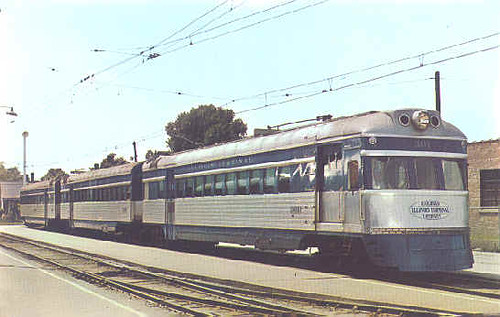

7010 & 7011 Catalog picture
Mr. Otis B Drinkwater comes through again. One page back I posted on the #7010 and #7011 sold by Montgomery Ward through their catalog.
Recently Mr. Drinkwater sent me a scan of the page from the Fall/Winter 1929-1930 catalog.
I’m glad to know what kind of consists each engine was leading. I just hope Mr. Drinkwater isn’t still trying to order from that catalog. [;)]
Enjoying the World’s Greatest Hobby
Northwoods Flyer
Per the #3020 discussion. If we go back to page 46 of the thread we can see that, as noted, the AF engine is a pretty good representation of the NYC electric as illustrated on the 1925-1927 catalog covers. While it is closer in appearance to the NYC engine I’m sure its visual approximation of an IC electric helped with sales in the Chicago area back when it was the top of the line engine in the O gauge lineup.
Montgomery Ward Freight Set
Back two entries I posted the above scan of the 1929-1930 Fall/Winter catalog. I went hunting through the boxes under the Blueboard Central to see if I could come up with a reasonable approximation of the Freight set.
This is what I came up with:
6 1/2 inch Enameled Passenger Cars
American Flyer first cataloged enameled passenger cars in 1933. They were 4 wheel versions. In 1934 the cars were offered with 8 wheel trucks. The enameled passenger cars disappeared from the 1936 and 1937 catalogs, only to reappear in 1938 and again in 1939 when they were cataloged for the last time.
There are 3 styles of car. Lets start with baggage cars.
This is version (E) - or at least close to it.
In the Guide to Pre War American Flyer Schuweiler states that this version has type VII trucks (which I think may be a typo as the photo in the book shows type VIII grey trucks). This example has type VIII trucks which are black. With a little closer inspection it is apparant that a previous owner painted the outside of the trucks black, but left the inside grey. Its a pretty nice job.
6 1/2 inch Enameled Passenger Cars - Correction and Update
A reader of this thread and fellow collector sent an email to me about some incomplete information that I posted in the previous entry. Flyer produced additional 6 1/2 inch enameled passenger cars at an ealier date - other than the ones I posted here . Let me share his email and the information he sent to me.
"I noted your latest post on the CTT thread and wanted to correct one item. You indicate that the 6.5 inch enamel cars were not introduced until 1933. That is not entirely correct. The style of car that you show was not introduced until 1933; however, the 6.5 inch wide-low type 3140, 3150, and 3160 series cars (depending on wheel and light configuration) were introduced in 1930 and were found in sets between 1930 and 1933 or 1934. I would guess you may have some, but if not they are similar to the 3170 series 8.25 inch cars which appeared around the same time.
They made these cars in both 4 and 8 wheel versions and in orange, red, green, blue green, and blue and made baggage, coach, and observation cars. The cars also were either lighted or unlighted. They were included in such sets as the New Bluebird, Frontenac, and Texan and came with boxcab and steam eng
This essentially is my first post to this thread, even though I have followed it on and off for a couple of years. The main reason I have not posted previously, is that I was having difficulty with the computer systems and I was unable to post and I could not figure it out.
However, since I have finally figured it out, I wanted to reach out and say how fascinating that Pre-War American Flyer is due to the number of variations that were made over the years.
I have been collecting Pre-War American Flyer for over 28 years and can remember having postwar S guage trains at the age of 4 or 5.
My interests in Pre-War Flyer include all of the Chicago era trains, with some emphasis on the Gilbert carryover Chicago items and pretty much no interest in Gilbert produced 3/16th scale trains.
It has also been nice to connect with and meet in person with some of the fellow collectors through this thread.
Although the trains are what is of interest to us all, the friendships made through the trains are more valuable to me than the trains. Going to local shows eventually led me to York and on to Cal-Stewart, and finally this year I attended my first TCA Convention. I went just because of a certain layout tour, but it was a great show/convention and I met with several friends and was able to purchase some great Pre-War Flyer at the convention.
Northwoods:
Two questions to pick your brain.In terms of Chicago production, I am strictly guessing that the two wheel cars ( versus four) were from that facility. What was the last identifiable run of production out of Chicago? Second question ( if I may) what year were the brass journal covers put on the trucks? Apologies if you have answered these previously further back in the thread.
Thanks in Advance
Bruce
The last identifiable run of production out of Chicago? The company was sold in early 1938, so the 1937 cataloged line would have been the last cataloged run. However, that leaves a lot to be answered as Gilbert did carryover some of the Chicago production items into 1938, 1939, and 1940.
For instance, the Hiawatha sets were discontinued after 1937. The green streamline cars are definitely Chicago production styling, with the 1938 line seeing the introduction of blue, red, and chrome streamline cars, with only 1 set featuring green cars, likely using up the existing stock. At some point the City of Denver set changes from a darker yellow color to a lighter yellow color, and this appears to likely be in 1938, with these yellow cars also being sold in a special set that included a steam engine instead of the UP engine. For the small 6.5 inch cars, in 1938 they retained the hook style couplers that the earlier production cars had and the larger 9 inch freights getting the curly-cue knuckle type couplers in 1938. These smaller cars had the curly-cue style couplers in 1939 and the larger cars got the link couplers. In 1940 the only chicago production style carryovers were the Yard King switcher set and a streamline passener set.
This carryover of Chicago production also is evident in some of the accessories, with the 97 freight station remaining the same in 1938 and 1939, but then in 1940 it featured the Chicago style building and platform with the gilbert 3/16 crane, which also came with either the early style simulated clay tile lithograph roof or a green crackle painted roof. In 1941, the 612 station set replaces the 97 freight station set.
I believe the last sets featuring a chicago production piece are some of the inexpensive 1941 freight and passenger sets which came with a chicago production style XX locomotive (per greenberg’s numbering system) and matching tender on 3/16 scale trucks which was sold with the tin Gilbert
Heres my Grandfather’s American Flyer set which he recieved in 1937 that has now been passed down to me. The only thing I’m currently missing is the light up caboose that came with it. I wrapped it up with paper and forgot to take it.[(-D]
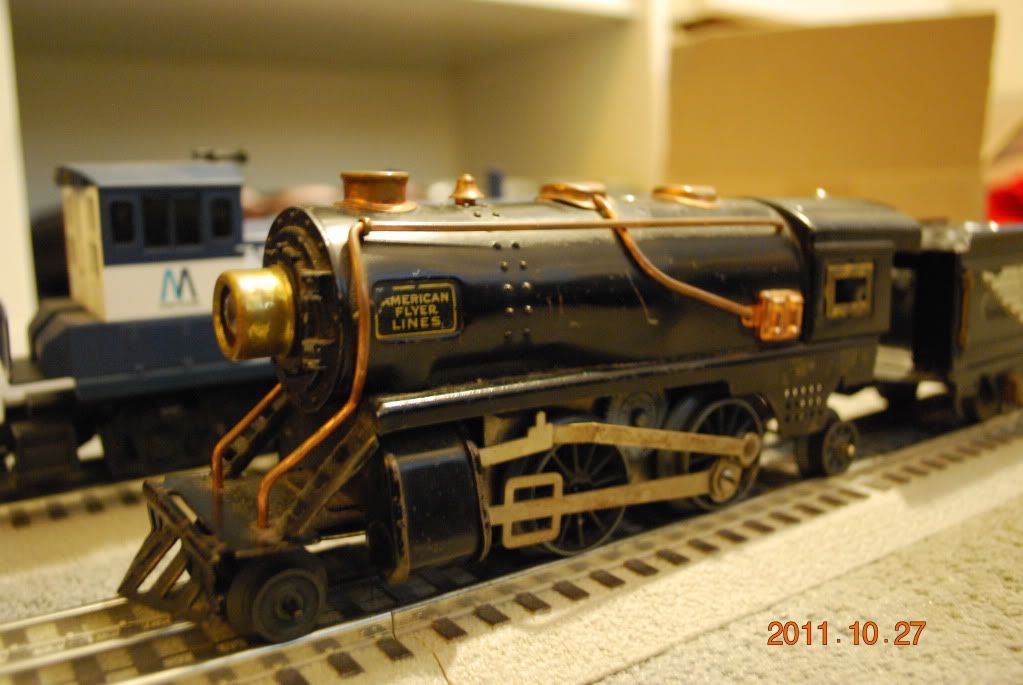
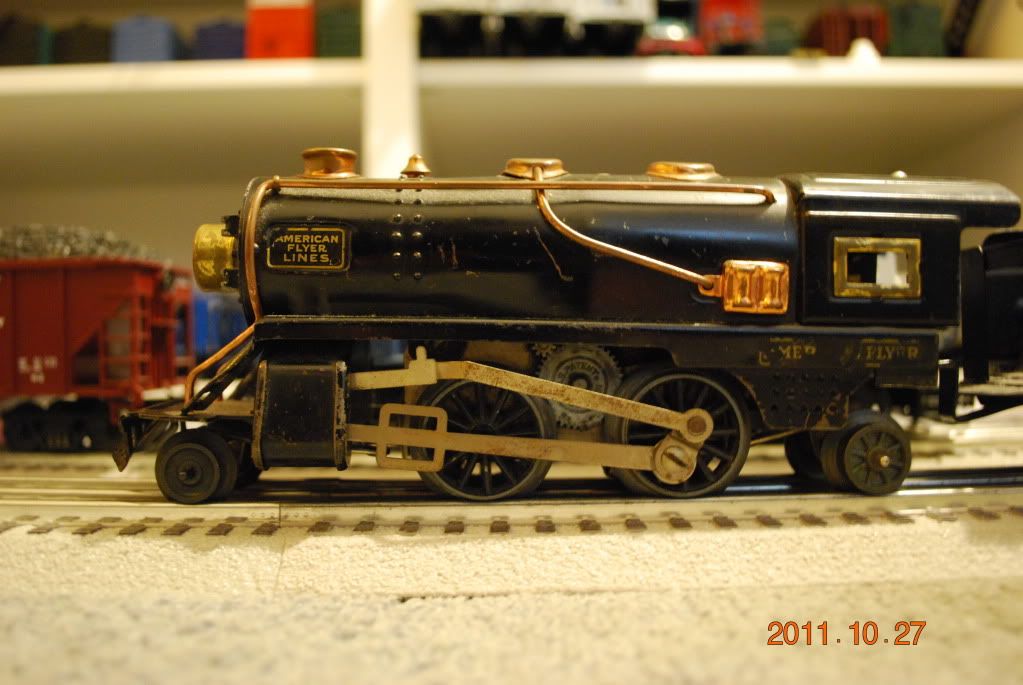
We had to have the engines trailing and pilot wheels replaced due to them practically rotting off.
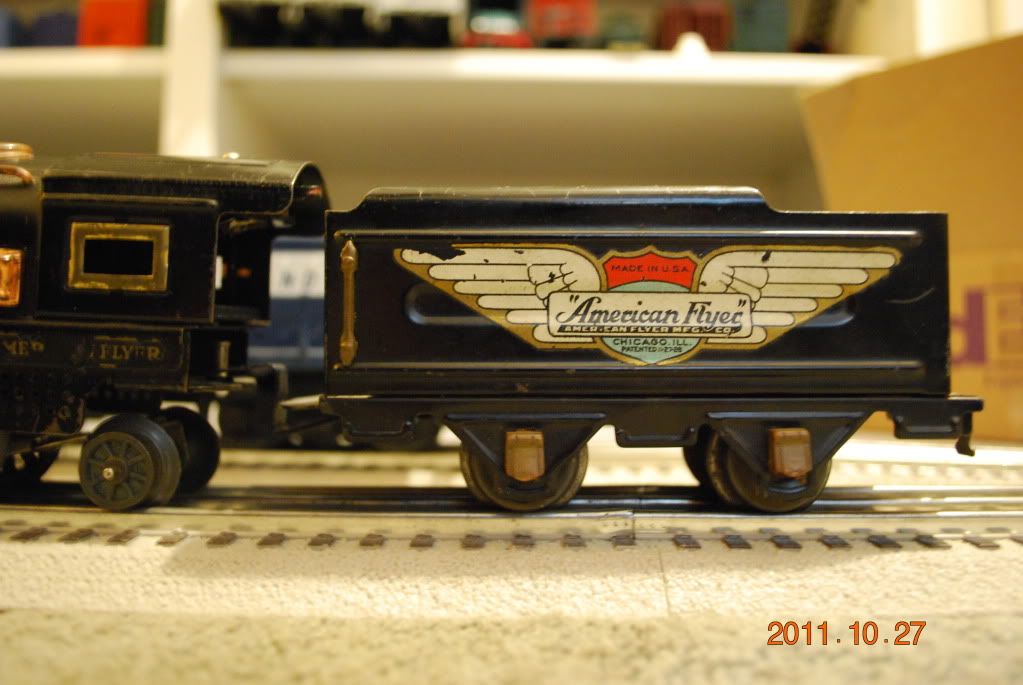
Heres the 3189 tender.
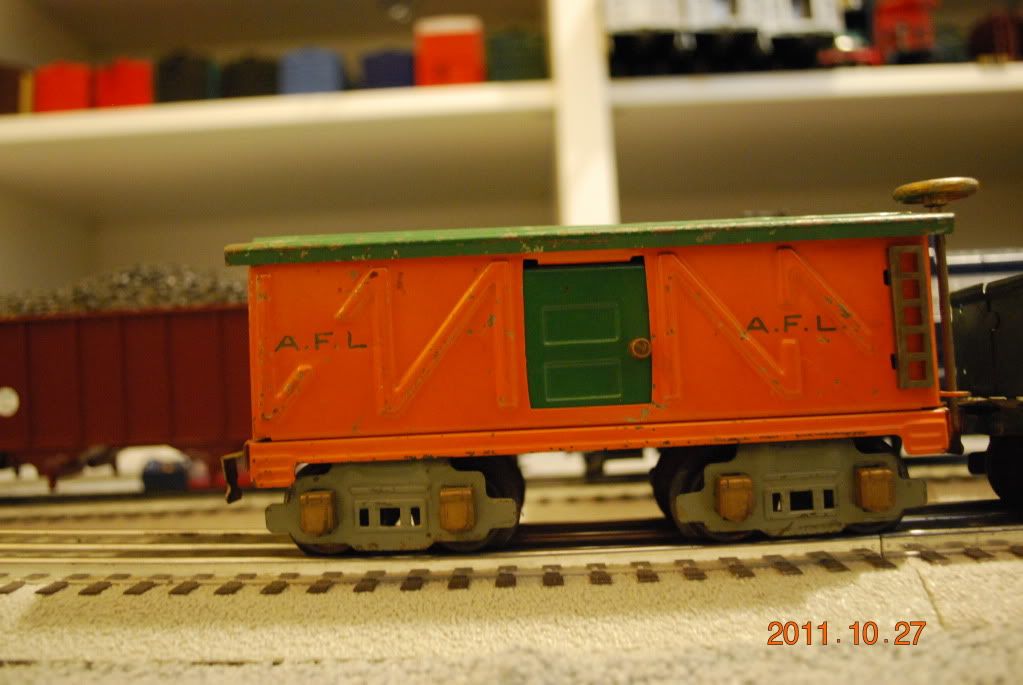
This boxcar dosent have a number stamped on the bottom oddly enough. it just says “INSP 2”
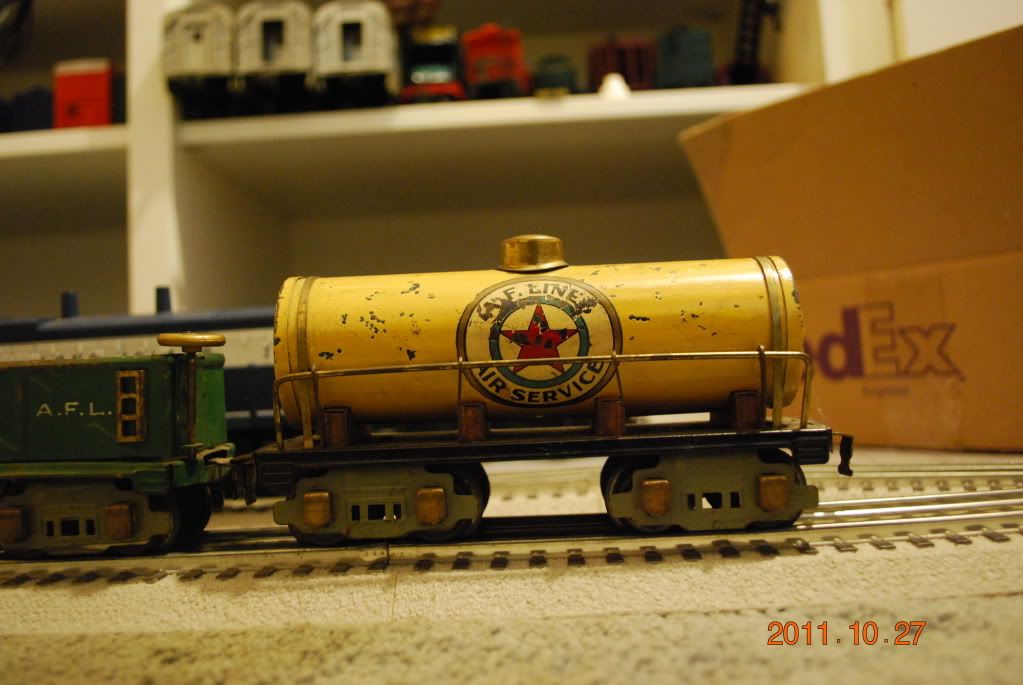
The 3018 air service tanker.
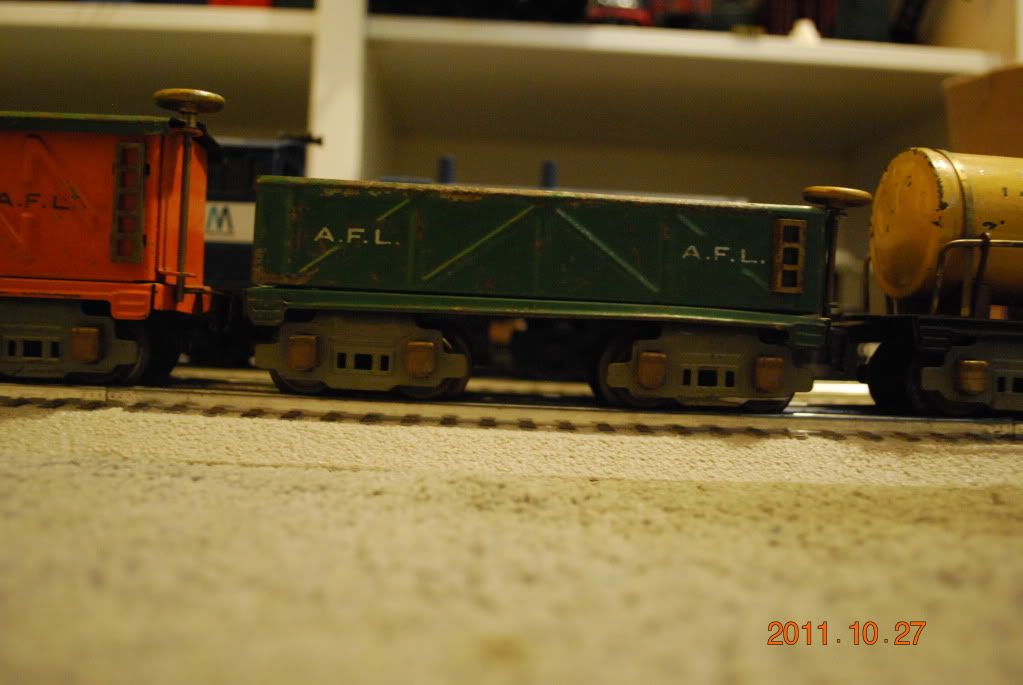
and finally, a 3016 gondola.
I’m very proud to be the owner of this set now. has alot of family history[;)]
That is a nice set; however, I would suspect that it is a few years earlier than you think. I would guess the set dates to around 1933-1934 due to the tender and air service tank car, which were produced earlier than 1937.
Look on ebay for a matching caboose, just match up the frame style and truck style to the other cars in your set.
Thanks for the info. Yeah, after looking on ebay and on a few sites, I kind of thought it might be older. Perhaps it was old stock in the store? who knows.
I have found the matching caboose on ebay, but I’m probably just better off picking up the caboose next time I’m at their house.
Also heres a question open to anyone, did the engine have a different wheel arrangment previously? or maybe a trailing truck? Whenever I find this engine on ebay, it always seems to have a different wheel sets. I cant exactly remember the wheels before we got them replaced. that had to be around 10-12 years ago. I just remember the old ones were rotted way beyond being able use them.
You are better off getting the caboose the next time you are at your relative’s house.
There were several different wheel arrangements used on these engines. The drive wheels look to be original, with both the leading and trailing wheels appearing to be replaced.







